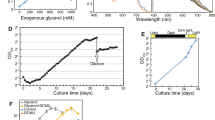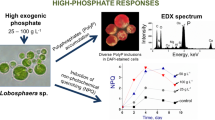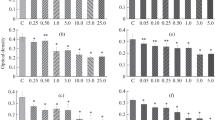Summary
The photosynthetic pigments of the marine algaCryptomonas maculata are decreased under energy fluence rates of 4.4 Wm−2 (high light=HL). That this is a result of nitrogen deprivation following an increased cell growth rate triggered by high light in comparison to the control under 1.28 Wm−2 (low light=LL) is evident from combined pigment, growth rate and nutrient analyses. Fine structural studies by electron microscopy revealed that the electron opaque material in the thylakoid lumen of the plastid is lost under high light treatment parallel to the severe loss of almost 90% phycoerythrin-545. The reduction of chlorophylla andc is accompanied by a reversible disorganization of the thylakoid packing and the thylakoid membranes.
In a combined freeze fracture study of HL and LL cells ofCryptomonas maculata it is demonstrated that the exoplasmic fracture face of the thylakoid membranes in HL cells possessed only 10 to 15% of the particles of the LL control; the 12.5 nm particle class was almost lacking, whereas particle populations with main sizes of 10 and 7.5 nm are preserved.
The protoplasmic face, on the other hand, was less severely affected with only slight reduction in the particle frequency and a shift of the particle size from two populations with peaks at 10 and 7.5 nm to one class centred around 7.0 nm.
Similar content being viewed by others
References
Antia, N. J., Chorney, V., 1968: Nature of the nitrogen compounds supporting phototrophic growth of the marine cryptomonadHemiselmis virescens. J. Protozool.15, 198–201.
Berkaloff, C., Duval, J. C., Hauswirth, N., Rousseau, B., 1983: Freeze fracture study of thylakoids ofFucus serratus. J. Phycol.19, 96–100.
Bisalputra, T., 1974: Plastids. In: Algal physiology and biochemistry (Stewart, W. D. P., ed.), pp. 124–160. Oxford-London-Edinburgh-Melbourne: Blackwell Scientific Publ.
Boussiba, S., Richmond, A. E., 1980: C-phycocyanin as a storage protein in the blue-green algaSpirulina platensis. Arch. Microbiol.125, 143–147.
Bowen, M. S., Ward, H. B., 1979: Laboratory culture ofCryptomonas ovata andChroomonas sp. (Cryptophyceae). Microbios. Lett.6, 77–84.
Branton, D., Bullivant, S., Gilula, N. B., Karnowsky, M. J., Moor, H., Muehlethaler, K., Northcote, D. H., Packer, L., Satir, B., Satir, P., Speth, V., Staehelin, L. A., Steere, R. L., Weinstein, R. S., 1975: Freeze-etch nomenclature. Science190, 54–56.
Brown, T. E., Richardson, F. L., 1968: The effect of growth environment on the physiology of algae: light intensity. J. Phycol.4, 38–54.
Christensen, T., 1962: Alger. In: Systematisk botanik 2 (Böcher, T. W., Lange, M., Sörensen, T., eds.), pp. 1–178. Copenhagen: Munksgaard.
Chu, Z.-X., Anderson, J. M., 1984: Modulation of light-harvesting assemblies in chloroplasts of a shade plantAlocasia macrorrhiza. Photobiochem. Photobiophys.8, 1–10.
Cloern, J. E., 1977: Effects of light intensity and temperature onCryptomonas ovata (Cryptophyceae) growth and nutrient uptake. J. Phycol.13, 389–395.
Dodge, J. D., 1969: The ultrastructure ofChroomonas mesostigmalica Butcher (Cryptophyceae). Arch. Microbiol.69, 266–280.
Dwarte, D. M., Vesk, M., 1983: A freeze-fracture study of cryptomonad thylakoids. Protoplasma117, 130–141.
Faust, M. A., Gantt, E., 1973: Effect of light intensity and glycerol on the growth, pigment composition and ultrastructure ofChroomonas sp. J. Phycol.9, 489–495.
Gantt, E., 1981: Phycobilisomes. Ann. Rev. Plant Physiol.32, 327–347.
—,Edwards, M. R., Provasoli, L., 1971: Chloroplast structure of theCryptophyceae. Evidence for phycobiliproteins within intrathylakoidal space. J. Cell Biol.48, 280–290.
GDCh, 1975: Deutsche Einheitsverfahren zur Wasser-, Abwasser- und Schlamm-Untersuchung, 3. Aufl. 1975 (Fachgruppe Wasserchemie in der Gesellschaft Deutscher Chemiker, ed.). Weinheim: Verlag Chemie.
Gibbs, S. P., 1970: The comparative ultrastructure of the algal chloroplast. Am. N. Y. Acad. Sci.175, 454–473.
Golecki, J. R., Drews, G., 1982: Supramolecular organization and composition of membranes. In: The biology of cyanobacteria (Carr, N. G., Whitton, B. A., eds.), pp. 125–141. Oxford-London-Edinburgh: Blackwell Scientific Publ.
Jeffrey, S. W., Humphrey, G. F., 1975: New spectrophotometric equations for determining Chlorophylls a, b, c 1 and c 2 in higher plants, algae and natural phytoplankton. Biochem. Physiol. Pflanzen167, 191–194.
Köst, H.-P., Senser, M., Wanner, G., 1984: Effect of nitrate and sulphate starvation onPorphyridium cruentum cells. Z. Pflanzenphysiol.113, 231–249.
Lichtlé, C., 1979: Effects of nitrogen deficiency and light of high intensity onCryptomonas rufescens (Cryptophyceae). I. Cell and photosynthetic apparatus transformations and encystment. Protoplasma101, 283–293.
—,Thomas, J. C., 1976: Etude ultrastructurale des thylacoides des algues à phycobiliprotéines, comparaison des résultats obtenus par fixation classique et cryodécapage. Phycologia15, 393–404.
Lucas, I. A. N., 1970b: Observations on the fine structure of theCryptophyceae. I. The genusCryptomonas. J. Phycol.6, 30–38.
Luft, J. H., 1961: Improvements in epoxy resin embedding methods. J. Biophys. Biochem. Cytol.9, 409–414.
MacColl, R., Berns, D. S., Gibbons, O., 1976: Characterization of cryptomonad phycoerythrin and phycocyanin. Arch. Biochem. Biophys.177, 265–275.
Miller, K. R., Cushman, R. A., 1979: A chloroplast membrane lacking photosystem II. Thylakoid stacking in the absence of the photosystem II particle. Biochim. Biophys. Acta546, 481–497.
Mörschel, E., Mühlethaler, K., 1983: On the linkage of exoplasmatic freeze-fracture particles to phycobilisomes. Planta158, 451–457.
—,Wehrmeyer, W., 1977: Multiple forms of phycoerythrin-545 fromCryptomonas maculata. Arch. Microbiol.113, 83–89.
Nultsch, W., Benedetti, P. A., Gualtieri, P., 1983: Microspectrophotometric investigations of photobleaching inAnabaena variabilis cells and heterocysts and its prevention by sodium azide. Z. Pflanzenphysiol.111, 327–332.
Provasoli, L., Mclaughlin, J. J., Droop, M. R., 1957: The development of artificial media for marine algae. Arch. Microbiol.25, 392–428.
Reynolds, E. S., 1963: The use of lead citrate at high pH as an electron opaque stain in electron microscopy. J. Cell Biol.17, 208–212.
Schmetterer, G., Peschek, G. A., Sleytr, U. B., 1983: Thylakoid degradation during photooxidative bleaching of the cyanobacteriumAnacystis nidulans. Protoplasma115, 202–207.
Staehelin, L. A., Arntzen, C. J., 1983: Regulation of chloroplast membrane function: protein phosphorylation changes the spatial organization of membrane components. J. Cell Biol.97, 1327–1337.
Stevens, S. E. Jr., Balkwill, D. L., Paone, D. A. M., 1981: The effects of nitrogen limitation on the ultrastructure of the cyanobacteriumAgamenellum quadruplicatum. Arch. Microbiol.130, 204–212.
Sweeney, B. M., 1981: Freeze-fractured chloroplast membranes ofGonyaulax polyedra (Pyrrophyta). J. Phycol.17, 95–101.
TandeaudeMarsac, N., 1983: Phycobilisomes and complementary chromatic adaptation in cyanobacteria. Bulletin de l'Institut Pasteur81, 201–254.
Thinh, L.-V., 1983: Effect of irradiance on the physiology and ultrastructure of the marine cryptomonadCryptomonas strain Lis (Cryptophyceae). Phycologia22, 7–11.
Vesk, M., Jeffrey, S. W., 1977: Effect of blue-green light on photosynthetic pigments and chloroplast structure in unicellular marine algae from six classes. J. Phycol.13, 280–288.
Wehrmeyer, W., 1970: Zur Feinstruktur der Chloroplasten einiger photoautotropherCryptophyceen. Arch. Mikrobiol.71, 367–383.
—,Schneider, H., 1975: Elektronenmikroskopische Untersuchungen zur reversiblen Veränderung der Chloroplastenfeinstruktur vonRhodella violacea bei Stickstoffmangel. Biochem. Physiol. Pflanzen168, 519–532.
Yamanaka, G., Glazer, A. N., 1980: Dynamic aspects of phycobilisome structure. Phycobilisome turnover during nitrogen starvation inSynechococcus sp. Arch. Microbiol.124, 39–47.
Author information
Authors and Affiliations
Rights and permissions
About this article
Cite this article
Rhiel, E., Mörschel, E. & Wehrmeyer, W. Correlation of pigment deprivation and ultrastructural organization of thylakoid membranes incryptomonas maculata following nutrient deficiency. Protoplasma 129, 62–73 (1985). https://doi.org/10.1007/BF01282306
Received:
Accepted:
Issue Date:
DOI: https://doi.org/10.1007/BF01282306




